

Reptiles of Yellowstone National Park
Reptile General Information
Cool, dry conditions limit Yellowstone's reptile to six species. Population numbers for these species are not known.
Yellowstone is home for a small variety of reptiles. Glacial activity and current cool and dry conditions are likely responsible for their relatively low numbers in Yellowstone.
In 1991 park staff began cooperating with researchers from Idaho State University to sample additional park habitats for reptiles and amphibians. This led to establishment of long-term monitoring sites in the park. The relatively undisturbed nature of the park and the baseline data may prove useful in testing hypotheses concerning the apparent declines of several species of toads and frogs in the western United States. Reptile and amphibian population declines may be caused by such factors as drought, pollution, disease, predation, habitat loss and fragmentation, introduced fish and other non-native species.
Although no Yellowstone reptile or amphibian species are currently listed as threatened or endangered, several including the boreal toad are thought to be declining in the West. Surveys and monitoring are underway to try to determine if amphibian populations are declining in Yellowstone National Park.
Index
| Yellowstone National Park Reptiles | ||
|---|---|---|
| Bull Snake | Prairie Rattlesnake | Rubber Boa |
| Sagebrush Lizard | Valley Garter Snake | Wandering Garter Snake |
Bull Snake
| Bull Snake |
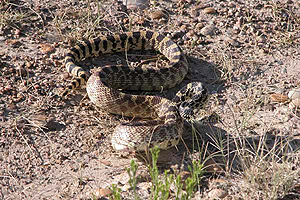 |
| Pitiophis catenifer sayi |
Bull Snake - Pituophis catenifer sayi
Identification
![]() A subspecies of the gopher snake, is Yellowstone's largest reptile, ranging from 50 to 72 inches long.
A subspecies of the gopher snake, is Yellowstone's largest reptile, ranging from 50 to 72 inches long.
![]() Yellowish with a series of black, brown, or reddish-brown blotches down the back; the darkest, most contrasting colors are near the head and tail; blotches are shaped as rings around the tail.
Yellowish with a series of black, brown, or reddish-brown blotches down the back; the darkest, most contrasting colors are near the head and tail; blotches are shaped as rings around the tail.
![]() Head resembles a turtle's in shape, with a protruding scale at the tip of the snout and a dark band extending from the top of the head through the eye to the lower jaw.
Head resembles a turtle's in shape, with a protruding scale at the tip of the snout and a dark band extending from the top of the head through the eye to the lower jaw.
Habitat
![]() In Yellowstone, found at lower elevations; drier, warmer climates; and open areas such as near Mammoth.
In Yellowstone, found at lower elevations; drier, warmer climates; and open areas such as near Mammoth.
Behavior
![]() Lives in burrows and eats small rodents-behavior that gave the gopher snake its name.
Lives in burrows and eats small rodents-behavior that gave the gopher snake its name.
![]() Often mistaken for a rattlesnake because of its appearance and its defensive behavior: when disturbed, it will coil up, hiss loudly, and vibrate its tail against the ground,
producing a rattling sound.
Often mistaken for a rattlesnake because of its appearance and its defensive behavior: when disturbed, it will coil up, hiss loudly, and vibrate its tail against the ground,
producing a rattling sound.
Prairie Rattlesnake
| Prairie Rattlesnake |
 |
| Crotalis viridis viridis |
Prairie Rattlesnake - Crotalis viridis viridis
Identification
![]() More than 48 inches in length.
More than 48 inches in length.
![]() Greenish gray to olive green, greenish brown, light brown, or yellowish with dark brown splotches down its back that are bordered in white.
Greenish gray to olive green, greenish brown, light brown, or yellowish with dark brown splotches down its back that are bordered in white.
Habitat
![]() Only dangerously venomous snake in the park.
Only dangerously venomous snake in the park.
![]() Lives in the lower Yellowstone River areas of the park, including Reese Creek, Stephens Creek, and Rattlesnake Butte, where the habitat is drier and warmer than elsewhere in the park.
Lives in the lower Yellowstone River areas of the park, including Reese Creek, Stephens Creek, and Rattlesnake Butte, where the habitat is drier and warmer than elsewhere in the park.
Behavior
![]() Usually defensive rather than aggressive.
Usually defensive rather than aggressive.
![]() Only two snake bites are known during the history of the park.
Only two snake bites are known during the history of the park.
Yellowstone Rubber Boa
| Rubber Boa |
 |
| Charina bottae |
Rubber Boa - Charina bottae
Identification
![]() Infrequently encountered in Yellowstone, perhaps due to its nocturnal and burrowing habits.
Infrequently encountered in Yellowstone, perhaps due to its nocturnal and burrowing habits.
![]() One of two species of snakes in the United States related to tropical boa constrictors and pythons.
One of two species of snakes in the United States related to tropical boa constrictors and pythons.
![]() Maximum length of 24 inches.
Maximum length of 24 inches.
![]() Back is gray or greenish-brown, belly is lemon yellow; scales are small and smooth, making it almost velvety to the touch.
Back is gray or greenish-brown, belly is lemon yellow; scales are small and smooth, making it almost velvety to the touch.
Habitat and Behavior
![]() Eats rodents.
Eats rodents.
![]() May spend great deal of time partially buried under leaves and soil, and in rodent burrows.
May spend great deal of time partially buried under leaves and soil, and in rodent burrows.
![]() Usually found in rocky areas near streams or rivers, with shrubs or trees nearby.
Usually found in rocky areas near streams or rivers, with shrubs or trees nearby.
![]() Recent sightings have occurred in the Bechler region and Gibbon Meadows.
Recent sightings have occurred in the Bechler region and Gibbon Meadows.
Yellowstone Sagebrush Lizard
| Sagebrush Lizard |
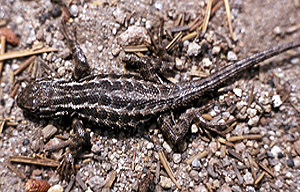 |
| Sceloporus graciosus graciosus |
Sagebrush Lizard - Sceloporus graciosus graciosus
Identification
![]() Only lizard in Yellowstone.
Only lizard in Yellowstone.
![]() Maximum size of five inches from snout to tip of the tail; males have longer tails and may grow slightly larger than females.
Maximum size of five inches from snout to tip of the tail; males have longer tails and may grow slightly larger than females.
![]() Gray or light brown with darker brown stripes on the back set inside lighter stripes on the sides, running the length of the body; stripes not always prominent and may appear as a pattern of checks down the back; underside usually cream or white.
Gray or light brown with darker brown stripes on the back set inside lighter stripes on the sides, running the length of the body; stripes not always prominent and may appear as a pattern of checks down the back; underside usually cream or white.
![]() Males have bright blue patches on the belly and on each side, with blue mottling on the throat.
Males have bright blue patches on the belly and on each side, with blue mottling on the throat.
Habitat
![]() Usually found below 6,000 feet but in Yellowstone lives up to 8,300 feet.
Usually found below 6,000 feet but in Yellowstone lives up to 8,300 feet.
![]() Populations living in thermally influenced areas are possibly isolated from others.
Populations living in thermally influenced areas are possibly isolated from others.
![]() Most common along the lower portions of the Yellowstone River near Gardiner, Montana and upstream to the mouth of Bear Creek; also occurs in Norris Geyser Basin, Shoshone and Heart Lake geyser basins, and other hydrothermal areas.
Most common along the lower portions of the Yellowstone River near Gardiner, Montana and upstream to the mouth of Bear Creek; also occurs in Norris Geyser Basin, Shoshone and Heart Lake geyser basins, and other hydrothermal areas.
Behavior
![]() Come out of hibernation about mid May and active through mid September.
Come out of hibernation about mid May and active through mid September.
![]() Diurnal, generally observed during warm, sunny weather in dry rocky habitats.
Diurnal, generally observed during warm, sunny weather in dry rocky habitats.
![]() During the breeding season males do push-ups on elevated perches to display their bright blue side patches to warn off other males.
During the breeding season males do push-ups on elevated perches to display their bright blue side patches to warn off other males.
![]() Feed on various insects and arthropods.
Feed on various insects and arthropods.
![]() Eaten by bull snakes, wandering garter snakes, rattlesnakes and some birds.
Eaten by bull snakes, wandering garter snakes, rattlesnakes and some birds.
![]() May shed tail when threatened or grabbed.
May shed tail when threatened or grabbed.
Valley Garter Snake
| Valley Garter Snake |
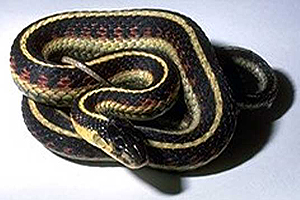 |
| Thamnophis sirtalis fitchi |
Valley Garter Snake - Thamnophis sirtalis fitchi
Identification
![]() Subspecies of the common garter snake.
Subspecies of the common garter snake.
![]() Medium sized snake reaching total length of up to 34 inches.
Medium sized snake reaching total length of up to 34 inches.
![]() Nearly black background color with three bright longitudinal stripes running the length of the body, underside is pale yellow or bluish gray.
Nearly black background color with three bright longitudinal stripes running the length of the body, underside is pale yellow or bluish gray.
![]() Most distinguishing characteristics of this subspecies in our region are the irregular red spots along the sides.
Most distinguishing characteristics of this subspecies in our region are the irregular red spots along the sides.
Habitat
![]() Thought to be common in the past, now in decline for no apparent reason.
Thought to be common in the past, now in decline for no apparent reason.
![]() Closely associated with permanent surface water.
Closely associated with permanent surface water.
![]() In Yellowstone observed only in the Falls River drainage in the Bechler region and three miles south of the south entrance along the Snake River.
In Yellowstone observed only in the Falls River drainage in the Bechler region and three miles south of the south entrance along the Snake River.
Behavior
![]() Generally active during the day.
Generally active during the day.
![]() In the Yellowstone area it eats mostly toads, chorus frogs, fish remains, and earthworms; can eat relatively poisonous species.
In the Yellowstone area it eats mostly toads, chorus frogs, fish remains, and earthworms; can eat relatively poisonous species.
![]() Predators include fish, birds, and carnivorous mammals.
Predators include fish, birds, and carnivorous mammals.
Wandering Garter Snake
| Wandering Garter Snake |
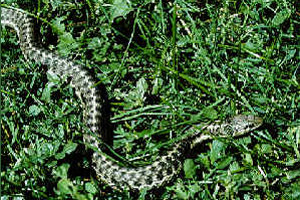 |
| Thamnophis elegans vagrans |
| Wandering Garter Snake |
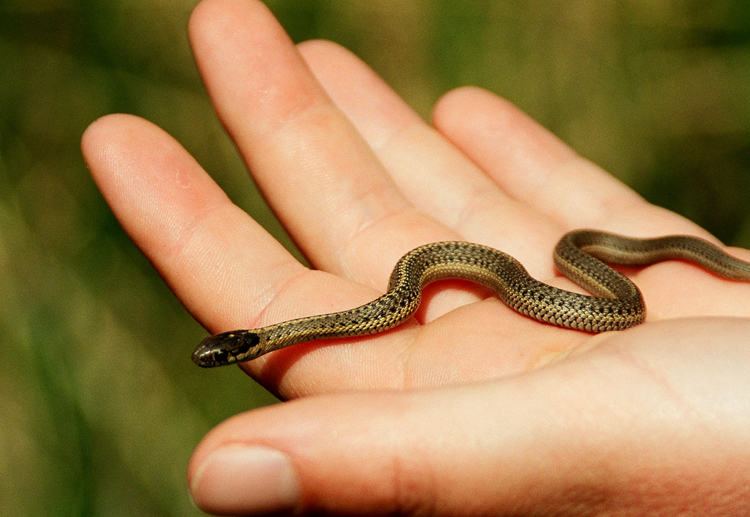 |
| Thamnophis elegans vagrans |
Wandering Garter Snake - Thamnophis elegans vagrans
Identification
![]() Most common reptile in the park.
Most common reptile in the park.
![]() 6 to 30 inches in length.
6 to 30 inches in length.
![]() Brown, brownish green, or gray with three light stripes-one running the length of the back and a stripe on each side.
Brown, brownish green, or gray with three light stripes-one running the length of the back and a stripe on each side.
Habitat
![]() Usually found near water in all areas of the park.
Usually found near water in all areas of the park.
![]() Eats small rodents, fish, frogs, tadpoles, salamanders, earthworms, slugs, snails, and leeches.
Eats small rodents, fish, frogs, tadpoles, salamanders, earthworms, slugs, snails, and leeches.
Behavior
![]() May discharge musk from glands at the base of the tail when threatened.
May discharge musk from glands at the base of the tail when threatened.
![]() Gives birth to as many as 20 live young in late summer or fall.
Gives birth to as many as 20 live young in late summer or fall.
Information provided by the NPS and "Amphibians & Reptiles of Yellowstone and Grand Teton National Parks" by Edward D. Koch and Charles R. Peterson.


| Yellowstone National Park WebCams | |||
|---|---|---|---|
| Old Faithful Live | All Old Faithful | Old Faithful Static | Old Faithful VC |
| North Entrance | Mt Washburn | Mammoth | YVO WebCam |
| Entrance Cities and Gateway Towns | |||
|---|---|---|---|
| Gardiner, Montana | Silver Gate, Montana | West Yellowstone, Montana | Cooke City, Montana |
| Livingston, Montana | Cody, Wyoming | Jackson Hole, Wyoming | Yellowstone National Park |

| Links | |
|---|---|
| The Great Outdoors Net | Great Outdoor Recreational Places |
| Gardiner, Montana | West Yellowstone, Montana |
 |
 |